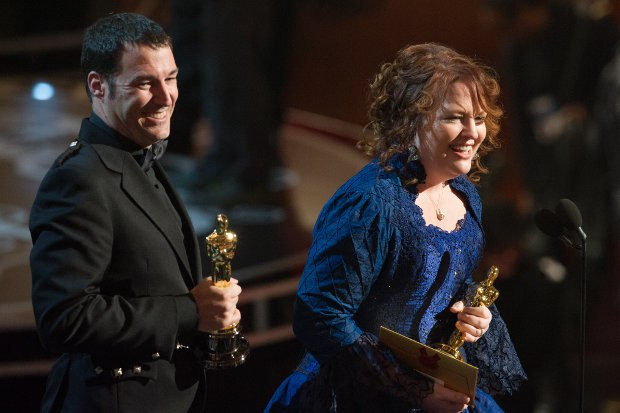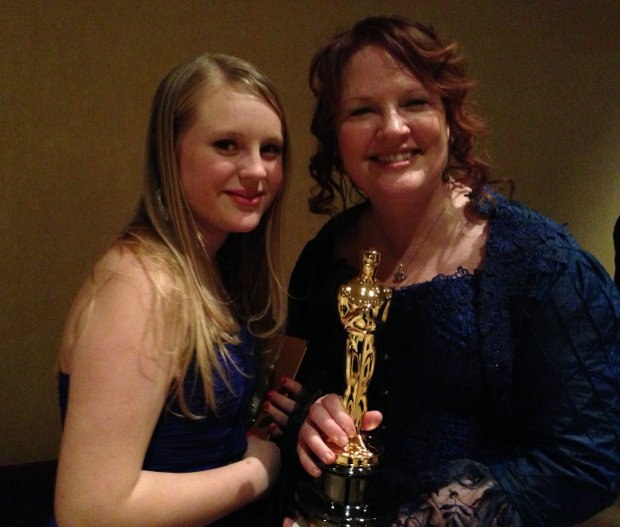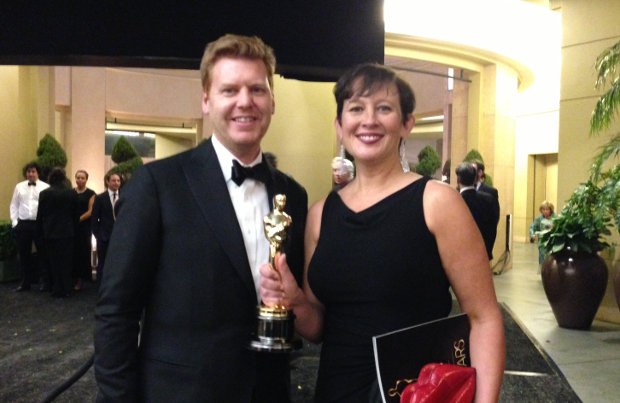Bill Desowitz reports backstage from the 85th Academy Awards on the animation and VFX winners.
Pixar and Disney were, of course, the big animation winners Sunday night at the 85th Academy Awards, with Brave and Paperman taking best feature and short. It just goes to prove that you can't underestimate the power and prestige of the Pixar brand. While most of us picked either Wreck-It Ralph or Frankenweenie to win, Brave ultimately proved to be the consensus choice among Academy members after winning the BAFTA and editing and sound mixing tech awards. As for Paperman, the innovative short from John Kahrs wore its heart on its sleeve while offering a 21st century innovative hybrid technique worthy of the Disney legacy.
I asked Brave directors Mark Andrews and Brenda Chapman about their ambitious movie and its bumpy road to success: "I think a magic in animation and filmmaking is how much of a collaborative process it is, where either if you're working side by side together the whole time or if it was like Brave where there was one director and then another director," Andrews replied. "The thing that I loved about Brenda's story was the thing that everybody loved about Brenda's story, and I wanted to honor that when I came on board for my part of it."
"Which I feel very much he did," added Chapman, whom he replaced after nurturing the project for six years. "And, you know, I told Mark when he stepped in that I was very happy that it was him who took my place because I know he has a daughter with three sons and I knew he would understand, but also he has a love of Scotland as well. I wasn't sure about his fairytale sensibility, but it's not a real fairytale anyway…"
"I mean, it's this huge organic process. And it's a fragile, delicate process on every step of the way. And there's a lot of plates to spin, and by the end if you just stick with it and you're passionate about it, hopefully, by the end you have something that's really special, and I think in Brave's case I think we managed to pull that off."
Andrews, wearing his kilt for good luck, concurred, "You know, it's a battle. It's a war. So to have the recognition not just from the Academy but from all the different organizations for your work on Brave has just been a remarkable and thrilling surprise. So, we're evened out."
For Kahrs, the Paperman short was a decade-long journey honing a unique love story in black and white while merging 2D and CG. "I just had this idea of like an urban fairytale about people that were perfect for each other but lost their connection," he explained. "But someone asked me, how is this short different than other Disney shorts, and I was tongue tied but now I realize it's the same as all other Disney...I mean, it has magic in it, it has appealing characters, it has the plausible impossible; it has all those great things..."
"But, yeah, it's a tall order to make the audience believe that these two people are a perfect couple from the very first shot. But I have a few tricks up my sleeve and I have amazing people at Disney on my team, especially from a design standpoint and an animation standpoint that do fantastic work."
Speaking of tricks up his sleeve, I asked Kahrs about his experimental approach, which he hopes to leverage into a feature someday: "We took the kind of old 2D animation and the newer CG animation and put them together in a way that I think hasn't been seen before. But I think what we did is take the drawn line and the expressiveness and the hand of the artist and bring it into the 21st century. So I'm really gratified by this and the acceptance of the audience to really look at that technique and that way of seeing animation and just letting the story kind of wash over them. So, yeah, I do believe that there are different ways that animation can look, and this is one of those ways."
Meanwhile, Life of Pi took the VFX award as expected for Rhythm & Hues and MPC, validating the brilliantly animated Richard Parker and the liquid gold virtual environment and turbulent storms at sea. But ironically, it also put the spotlight on the ailing industry and the bankrupt R&H. In fact, amid protests by VFX artists outside, it was the perfect opportunity for Bill Westenhofer to address these concerns. Unfortunately, he was cut off at the end of his acceptance speech, but he finished his remarks backstage.
"What I was trying to say up there is that it's at a time when visual effects movies are dominating the box office, that visual effects companies are struggling," Westenhofer suggested."And I wanted to point out that we aren't technicians. Visual effects is not just a commodity that's being done by people pushing buttons. We're artists, and if we don't find a way to fix the business model, we start to lose the artistry. If anything, Life of Pi shows that we're artists and not just technicians."
I followed-up with Westenhofer about his concerns regarding the future of R&H: "It was a place that really catered to the artist and supported them really well. It is a concern. We're hopeful that we can pull through the bankruptcy, but it's a concern in all of our minds that the culture is preserved. As long as the key people are maintained in that environment, I think it will carry on."
--
Bill Desowitz is former senior editor of AWN and VFXWorld, the owner of Immersed in Movies (www.billdesowitz.com), a columnist for Thompson on Hollywood at Indiewire and author of James Bond Unmasked (www.jamesbondunmasked.com), which chronicles the 50-year evolution of 007 on screen, featuring interviews with all six actors.
Dan Sarto is Publisher and Editor-in-Chief of Animation World Network.












